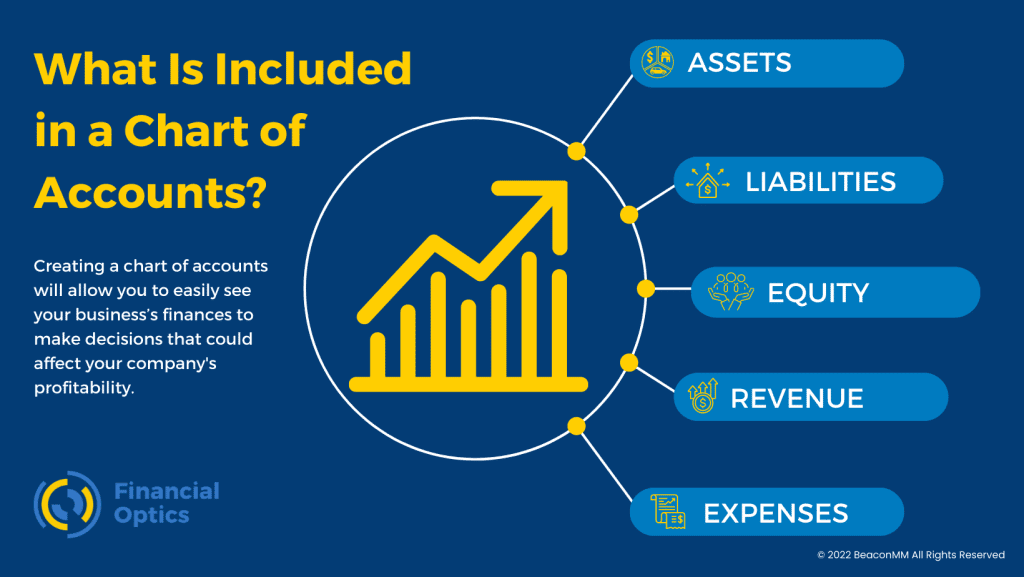Understanding all factors of your finances is essential for growing your small business. When you look at the numbers, you can further break down what is making your business successful or not successful and use that as a tool for growth.
Analyzing the individual factors of assets, revenue, and more can help you create a plan that increases the numbers in each category. However, looking at the combined numbers and overall financial report will give you a clear trajectory of how your business is doing.
So, what is a chart of accounts, and why is one important for small business bookkeeping? Here’s a guide on how a chart of accounts will maximize the understanding of your business’s success and allow you to grow in the future through evidence-based data.
Are you in need of a small business bookkeeping service? Contact Financial Optics today to see what services you can get!
What Is a Chart of Accounts?
A chart of accounts is a tool that allows you to analyze your financial activities over time. They compile your accounts into one area to better understand how your business is doing.
It comprises five factors: your assets, liabilities, equity, revenue, and expenses. Depending on your business there may be a sixth category tracking Cost of Goods Sold. Having these five factors available for analysis can help you see your business’s success. You can see where your money is going and how your business is growing.
Creating a chart of accounts will allow you to easily see your business’s finances to make decisions that could affect your company’s profitability. A proper chart of accounts is the foundation for useful financial reporting and analysis.
How Can a Chart of Accounts Help Your Small Business?
You can also use the chart of accounts for a quick and concrete information pool when making decisions regarding your business goals. If you’re unsure if you’ll have the capacity for a new investment or change the direction of your company, you can use this data to make educated decisions.
It’s a great way to have all of your important financial reports in one place. It allows you to see your overall growth every month and visually see the trajectory of your business. If there are dips or highs in specific months, you can further investigate why and help you avoid or make those decisions again.
It can also show you which areas you need to improve upon. You may make it a goal to lower your expenses or increase your revenue over time. Whichever you decide, you can see the small progressive steps when making your educated business decisions.
Using the following five factors in the chart of accounts can play a role in how they help you make better business decisions in the future.
1. Assets
Your business assets are one of the most important things to analyze. An asset is an item of value that your company owns. This can include tangible goods, tangible items, or intellectual property.
Some examples of assets include:
- Cash
- Accounts receivable
- Investments
- Office equipment
- Machinery
- Real estate
- Company-owned vehicles
You can analyze your assets, so you know the value of your business. It can also help you make decisions on what assets are a priority and what other investments you should be making in the future. Your asset list can help you see which things are helping or possibly hindering your business.
2. Liabilities
Liabilities include everything your business owns, presently or in the future. One of the most prominent liabilities is a loan. Your liabilities list can include things such as:
- Bank debt
- Mortgage debt
- Money owed to suppliers (accounts payable)
- Wages owed
- Taxes owed
Analyzing your liabilities will ensure that you’re cognizant of your debts and make the appropriate decisions to continue paying them. If you want to invest in something new but have high liabilities, it may not be the right move.
3. Shareholder’s Equity
Shareholder’s equity is what’s left after subtracting your company’s liabilities from its assets. It also includes the amount that investors have put into your company, including money or retained earnings over time. Your equity comprises three categories: common shares, preferred shares, and retained earnings.
Using the chart of accounts to analyze the shareholder’s equity allows companies to manage their finances quarterly or within the accounting year to see if their business is worth an investment. If you’ve proven to your initial investors that your business is profitable, it will allow you to seek other investors to prove why your business is worth taking a chance on.
Are you interested in getting help with your bookkeeping? Contact Financial Optics today!
4. Revenue
The revenue of your business shows the sales that you’ve made on your goods or services. It can include factors such as:
- Sales
- Sales returns
- Sales discounts
Considering the state of your revenue before making business decisions is crucial. If you’re planning on investing more into one of your particular goods or services, you need to understand which one will be worth the time and allow an ROI. It will also show how much money you can invest in other projects.
5. Expenses
Your company’s expenses include the types of money and resources it takes to generate revenue. Some expenses could consist of:
- Paying your employees
- Production costs
- Rent
- Travel expenses
- Utility bills
These are costs that typically can be hard to mitigate as you find more efficient ways to run your business. However, you can use this list to understand which factors you could cut to improve your profitability.
If you are tracking Cost of Goods Sold for your business, these accounts will track the direct costs of producing your product or service. These could include product costs, direct wages costs, or direct services costs.
How to Make a Chart of Accounts
Creating a chart of accounts can take some time the first go around, but it requires minimal maintenance. The following steps are a way to create a chart of accounts that will be easy to organize and read everything.
- Having the proper number of accounts can be tricky. You’ll want enough detail to properly track departments and product or service lines, but not too much that your financial statements become cluttered and unreadable.
- If you need account numbers (your software may not require it), coordinate your account numbers so they’re easy to recognize. They’re typically listed as follows:
- Asset Accounts: 101-199
- Liability Accounts: 201-299
- Equity Accounts: 301-399
- Revenue Accounts: 401-499
- Expense Accounts: 501-599
- Assign your accounts to the proper categories above, such as “utilities” categorized as an expense account.
- You can use accounts and sub accounts to group detail accounts together, such as all payroll expense accounts under payroll.
After you’ve initially set it up, you can use this organization tool moving forward, so everything is in one place and easily understandable for anyone to look at.
How Can Financial Optics Help You?
Financial Optics is a small business bookkeeping service that can help you achieve the same growth and longevity as a large company. We take charge of your finances by working with an accounting team that goes above and beyond for your business.
As a small business owner, you don’t want to worry about your business’s finances and being compliant with all accounting rules. Outsourcing your accounting allows you to focus on the business you’re passionate about. It also allows you to pick and choose the bookkeeping or accounting services you want and need for your small business.
We also work with you and can provide virtual CFO services to get financial insight into your business that will help you make beneficial business decisions. If you want another opinion about how your finances impact the future of your business, we’ve got your back.
Don’t waste time on the menial bookkeeping tasks that our staff at Financial Optics can professionally do. We’ll take care of your accounting so you can focus on providing your community with your amazing services or products.
Are you ready to outsource your bookkeeping? Schedule your Financial Optics consultation today!


